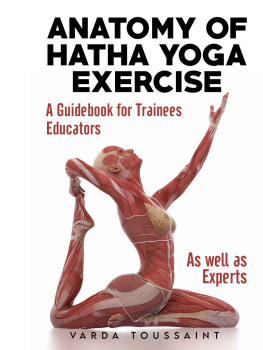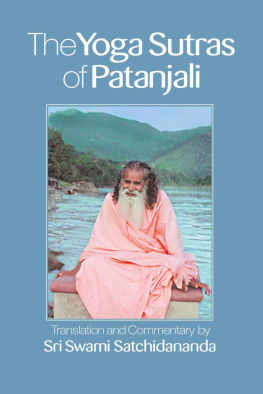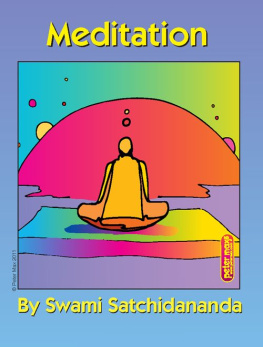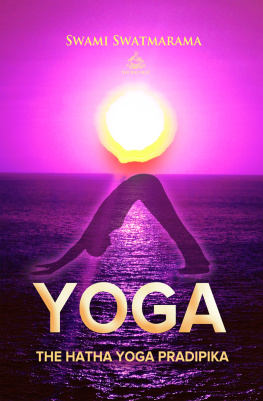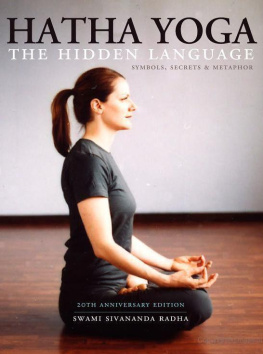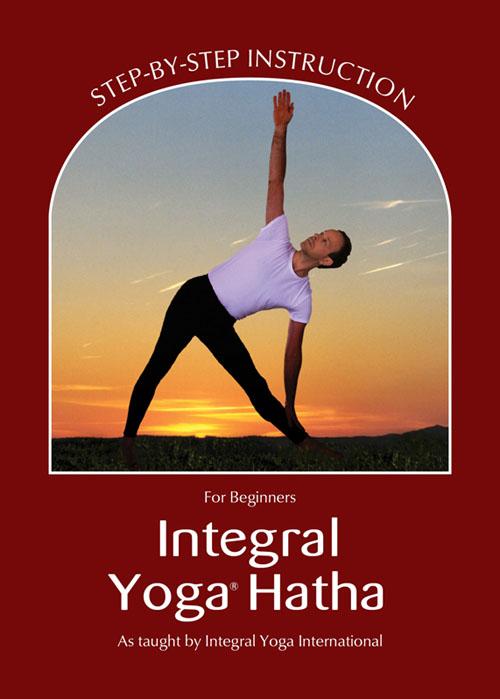
For more complete information about Hatha Yoga please refer to INTEGRAL YOGA HATHA by Sri Swami Satchidananda, Integral Yoga Publications, 1995, or consult Satchidananda AshramYogaville or any Integral Yoga Institute.
INTEGRAL YOGA PUBLICATIONS
108 Yogaville Way, Buckingham, Virginia 23921
Sixth Printing: 8,000 copies; 2001
Revised: 6,000 copies; 2009
ISBN 978-0-932040-64-0
Our deepest gratitude to Lakshmi Sutter, eRYT500, who edited, revised and updated this booklet so the description of each Yoga posture corresponds to our present Integral Yoga Basic Hatha Yoga I teacher training manual. Many thanks to Kristofer Marsh and Swami Hamsananda for their careful copy editing of this manuscript.
Copyright 1979, 2009 by Satchidananda AshramYogaville. All rights reserved, including the right to reproduce this booklet or portions thereof in any form.
Introduction
The goal of Yoga is to have a peaceful, clear mind in a sound, healthy body. Hatha Yoga is the practice of Yoga that approaches this goal through the physical aspect of the individual. On the beginners level it includes bodily postures (sanas), breathing techniques (pryma), cleansing practices (kriyas) and deep relaxation. The postures make the spine supple and healthy. The gentle pressure of the sanas promotes fresh blood circulation throughout the body which tones the all-important endocrine glands and digestive organs, creating both physical and psychological benefits. Proper relaxation returns the body to its own natural state of health and ease. Breathing practices can improve respiratory function and expel toxins. These practices also have a profound effect on the mind, making it more relaxed, poised and centered.
Many have found great healing benefits through a regular Yoga practice. People of any age or physical condition, even stiff, tense or overweight, may practice Hatha Yoga. These conditions often change with regular relaxed practice. In the case of acute or chronic illnesses, it is advisable to consult a Yoga therapist before commencing practice. We recommend that women during their menstrual periods avoid the inverted poses, rapid diaphragmatic breathing, retention of the breath in the pryma practices and be careful not to overstretch in the sanas. Pregnant women should consult The Mother is the Babys First Guru by Sri Swami Satchidananda for appropriate Hatha Yoga practices. Children under twelve may certainly practice Hatha Yoga but should avoid half spinal twist and the more difficult Hatha Yoga II poses like headstand, peacock pose and stomach lift (uddyna bandha), which are not shown in this booklet.
To obtain maximum benefit, we recommend embracing a simple vegetarian diet and avoiding strong stimulants. Do not be concerned if you find this difficult in the beginning. The body will tend to lose its desire for these things with regular Yoga practice.
Hatha Yoga practice should be done on an empty stomach while wearing loose, unrestricting clothing. The location should be airy but without drafts. Avoid the very hot sunshine. Be sure the spot is level. You may spread out a thick rug, folded blanket or Yoga sticky mat. If you wish to combine Hatha Yoga with athletic games or other exercises, do the latter first or at another time of day. It is strongly recommended to adhere to the times given in this book for each practice and to avoid straining. As Sri Swami Satchidananda tells us, Take it easy, but not lazy.
The basic Integral Yoga class is presented in this booklet. The order of the chanting, Yoga poses, breathing techniques and meditation in this booklet reflects their sequence in a typical Integral Yoga class. You may choose to include one or two optional poses in your daily practice. Cat/Cow pose may be done before the Sun Salutation, and the standing poses may be done after the Sun Salutation or right before Yoga Mudr (see pages 910). All of the other optional poses may be incorporated right before Yoga Mudr (see pages 2022).
Chants
As Hatha Yoga is a mental, energetic and spiritual practice as well as a physical one, it is beneficial to begin the practice with a chant or prayer.
Centering
Sit in a comfortable seated position, with the legs crossed if comfortable. Check the posture, have the spine erect but not stiff, shoulders back and relaxed down, head centered and eyes closed. Take a few deep breaths and begin to relax.
Opening Chants
OM OM OM Om sequence (pitch): middle, high, low
Hari OM Middle, low, high, high, middle, low, last 1/2 low

Netra Vyyamam: Eye Movements

Vertical: Sit in a cross-legged position with the spine erect and head still. Move the eyes up and then down as far as possible without strain. Repeat a few times; then close and relax the eyes.

Horizontal: Move the eyes horizontally straight across the center of the vision from far right to far left. Repeat a few times, then close and relax the eyes.

Diagonal: Move the eyes from upper right to lower left corner of the vision a few times, then repeat from upper left to lower right. Close and relax the eyes.

Full Circle: Move the eyes clockwise in a full circle, passing through all points on the circle. Repeat 34 times, then close and relax the eyes. Reverse, moving eyes counterclockwise, 34 times.
Now with eyes closed rub the palms briskly together until they are very warm. Cup them over the eyes, blocking out all light. Feel the darkness and let your eyes absorb the warmth. When they feel fully relaxed, bring the fingertips to the eyes and lightly stroke the eyelids outward toward the ears a few times. Return the hands to the lap, and feel the effects.
Benefits: Exercises and relaxes eye muscles, increases circulation, tones the optic nerves and is a general aid to the improvement of the eyesight. Prepares the brain for experiential learning and can reduce depression.
Srya Namaskram: Sun Salutation

#1: Place the feet parallel, either together or a comfortable distance apart, palms together in front of the chest. Exhale.

#2: Inhale. Lock the thumbs, stretch the arms out and up alongside the ears. Stretch up and gently bend back from just below the shoulder blades.


